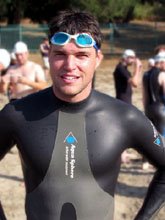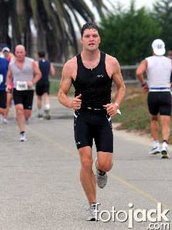 Between the hours I spend carving out six-packs, loading and unloading Olympic barbells, and wiping up clients' sweat, I try to pretend to be a normal human being interested in normal human things like politics and NASCAR, but it can be tough sometimes. I can't seem to help seeing things through the lens of a Fitness Guy.
Between the hours I spend carving out six-packs, loading and unloading Olympic barbells, and wiping up clients' sweat, I try to pretend to be a normal human being interested in normal human things like politics and NASCAR, but it can be tough sometimes. I can't seem to help seeing things through the lens of a Fitness Guy. I take comfort in thinking that Einstein probably couldn't help but contemplate time's inexorable bend as he waited for a tardy date; or that Mozart probably heard music in the pitter-pat of rain on his roof; or that the Heat Miser probably perceives a kind of delicate beauty in the gradual liquification of candle wax. Similarly, I can't help seeing people as the sum total of the size and tonus of their contractile tissue, and how and what might be done to rearrange and retool the shape that tissue assumes as it moves its owner through the world.
Example: the other day I was watching CNN, and a clip of Barack Obama came onscreen. I was making a real attempt at having a serious listen to him when an occupational twitch kicked in: instead of focusing on the good Senator's words, I started honing in on his NECK:
Geez, that guy could really stand to gain some solid, muscular weight. He needs to lay off the pick-up basketball, up his protein intake, and go for some serious work on squats and deads. And maybe some O-lifts, too, to thicken up the neck, traps and upper torso. Perhaps throw in a few isolation moves for the arms so he fills out the shirt sleeves a little more? Looks good to have a popping bicep when you're hoisting babies on the campaign trail. Of course he's an ecto, so we've got to get him out of the gym fast...
When I shook myself out of my regimen-planning reverie, they were on to the already very fit and energetic-looking John Edwards, for whom designing a workout program would be a lot less fun, so I lost interest.
But then I got to thinking: I may be a fitness freak and all, but surely other people have had the same thought. Maybe even most people. After all, Obama's svelte physique is an integral part of who he is, and it will, in fact, have something of an influence on his effectiveness if we decide to give him the job: it will affect how he comes across to other world leaders; to congress and the rest of Washington, and, of course, to us, every time we see him delivering a speech or boarding Air Force One or strolling through the Rose Garden. Wheelchair-bound Franklin D. Roosevelt made a savvy call when he decided to have himself propped up with braces when he appeared in public: the president is the embodiment of the country, after all, and no matter how capable his mind, you want that body to appear strong as well. It's a significant factor in that mysterious and irrational split-second calculation we run in our animal brains when we decide--almost without our conscious participation--whether or not we deem a candidate "presidential."
Consider: just about all our presidents have been physically impressive. Of the 42 presidents to date, only 11 have been below the average CURRENT adult male height of 5' 9." Average height has risen, of course, meaning that earlier, shorter presidents still may have been above average height for their era. Eighteen of them--nearly half--have been a full six feet or more. And the trend seems to be even more pronounced since the advent of television and ubiquitous news images: take away a couple of single-term exceptions (five-foot-niners Harry Truman and Jimmy Carter), and you've got to go all the way back to 1900, and the five-foot-seven William McKinley, to find a president much under six feet tall.
But height is only part of the 'physically impressive' equation. Stats on the weights of US presidents are a little tougher to come by, but judging from the numbers available, descriptions, potraits and photographs, it would appear we like our presidents to be rather more beefy than average. In a website dedicated to the medical histories of our presidents,Monroe and Johnson are described as "massive;" Zachary Taylor as having been "big and barrel chested;" Garfield as "very strong, athletic, and muscular." Even the diminutive Benjamin Harrison is described, at five-foot-six, as having a "big torso and strong muscles." Chester Arthur was trim but powerful at 6'2" and 185; JFK was a touch over six feet and around 180. At 6' 1", media-savvy exercise fiend Ronald Reagan appeared to be about 200 very muscular pounds; Clinton had a bit of a gut but still looked powerful in his presidential finery at six-two and 220. And, according to the New York Times, six-footer George W. Bush now tips the scales at 194. Whatever else one might think of him, I bet he could take Osama in a cage match.
There are outliers, certainly: Jefferson was tall and thin, as were John Tyler and Andrew Jackson (whose sylphlike frame once helped him avoid death by a duellist's bullet). Madison was tiny, both in height and weight, and McKinley was ridiculed by opponents as having a frame like a little boy's. At 320 pounds, Taft was morbidly obese, and the chubby Grover Cleveland wasn't far behind. For all his rough riding, Teddy Roosevelt was himself close to clinically obese, though it's hard to fault the physique of a guy who took exercising so seriously that he lost the sight in one eye as the result of a White House boxing match:
"Chad, put down those law books and lace up my gloves, will you? I understand you did a touch of the boxing while in the military...well be a good citizen and give your President a taste of your 'sweet science,' eh? No holding back, now, there's a good..." [THUD].
So the ideal presidential physique appears to be, not surprisingly, perhaps, pretty close to that of most male movie stars: on the tall, trim, athletic side, somewhere along the meso-ectomorphic border. It makes a kind of sense: a taller guy can see and be seen a hair better than a shorter guy, meaning he's got an advantage when it comes to working a room; his long arms can reach out to shake more outstretched hands; a pair of wider shoulders guy will get you more space from others in the room, making you appear even bigger. Sure, we're a few million years off from being primates, but the silverback in the room still makes us sit up and take notice.
Height-wise, Obama's pretty solidly in the ballpark: at six-two, he's is in the rarified territory occupied by presidential giants Thomas Jefferson, George Wahington, FDR, as well as more recent 74-inchers George H.W. Bush and Bill Clinton, though he's still a good two inches shy of the presidential height record, still held by Obama's political idol, the six-foot-four-inch Abraham Lincoln.
(Quick fact about Abe: apparently he had a loud, shrill voice--not something you'd think would be an asset to a president-- until you remember that he would have had to give speeches to assembled audiences without modern amplification: the louder he was, the more people he could reach, impress, and convince. Nowadays, of course, a candidate who doesn't sound measured and cool on the mic--think Howard Dean-- would be unelectable.)
Looking at the shot of Barack on the beach, it's clear he's in pretty great shape for a guy his age, especially a busy one. But I still can't help thinking that Barack could help his cause if put some more muscle on his lanky frame: he's got the height, but with a few extra pounds of contractile tissue to his name, he'd move with more authority, exhude more gravitas, and look more like he belonged in the pantheon of US presidents.
I even wonder whether, more than a simple aesthetic hiccup, Obama's slight physique might in fact be the real source of what appears to be his most significant stumbling block. When voters say that they're worried about Obama's "experience," how many of them have actually checked his resume (which is, in fact, about as varied and challenging as you could expect a relatively young politician's to be), and how many are just looking at his physique and thinking, "He looks kind of skinny"--which somehow translates into 'inexperienced' when they answer polls? It's impossible to know, of course, but I'm going to speculate wildly that a large part of what people are responding to when they say "Obama lacks experience" isn't his track record but his BODY. Obama's whippet-thin physique looks like that of a young and inexperienced man, so we think that he must be, even if the facts tell us otherwise.
The solution? Hit the weight room, Barack.
Hey, I'll even design your program for you. It could be centered around baby-hoisting for the delts and hand-shaking for the forearms. All I'll ask in return is a token cabinet position in the event of your election.
(All information on presidential health and fitness was taken from here and here.




